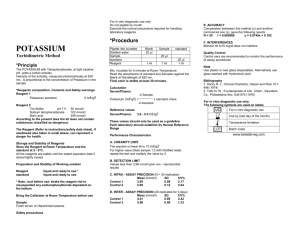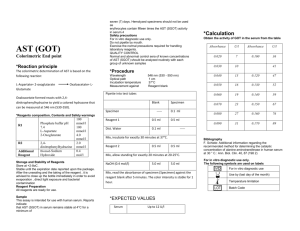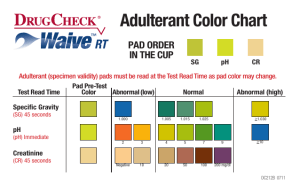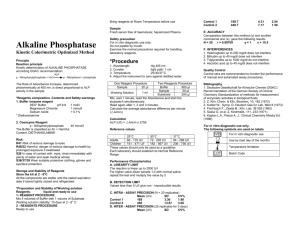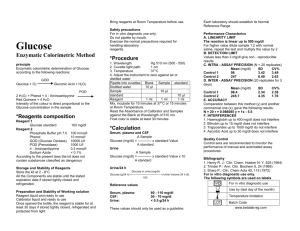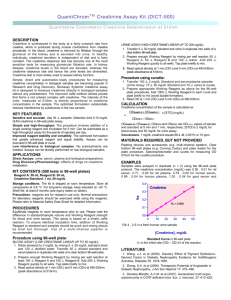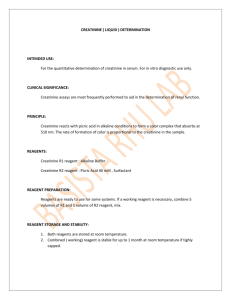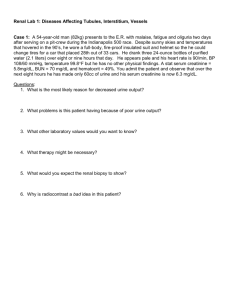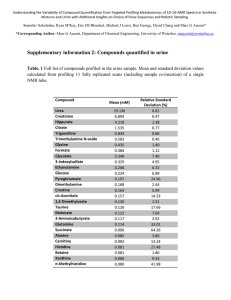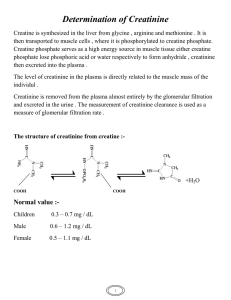Creatinine Kinetic Colorimetric Method Lab Protocol
advertisement
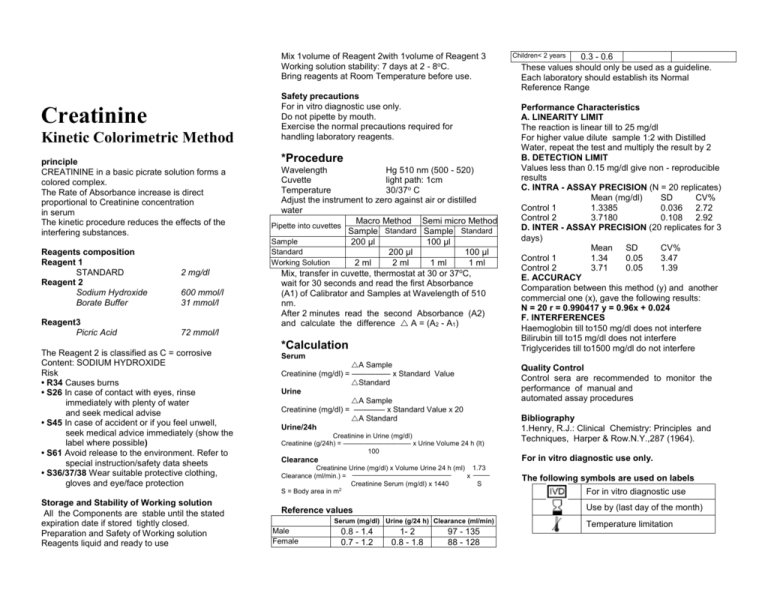
Mix 1volume of Reagent 2with 1volume of Reagent 3 Working solution stability: 7 days at 2 - 8oC. Bring reagents at Room Temperature before use. Creatinine Kinetic Colorimetric Method principle CREATININE in a basic picrate solution forms a colored complex. The Rate of Absorbance increase is direct proportional to Creatinine concentration in serum The kinetic procedure reduces the effects of the interfering substances. Reagents composition Reagent 1 STANDARD Reagent 2 Sodium Hydroxide Borate Buffer Reagent3 Picric Acid 2 mg/dl 600 mmol/l 31 mmol/l Safety precautions For in vitro diagnostic use only. Do not pipette by mouth. Exercise the normal precautions required for handling laboratory reagents. *Procedure Wavelength Hg 510 nm (500 - 520) Cuvette light path: 1cm Temperature 30/37o C Adjust the instrument to zero against air or distilled water Macro Method Semi micro Method Pipette into cuvettes Sample Standard Sample Standard Sample 200 µl 100 µl Standard 200 µl 100 µl Working Solution 2 ml 2 ml 1 ml 1 ml Mix, transfer in cuvette, thermostat at 30 or 37oC, wait for 30 seconds and read the first Absorbance (A1) of Calibrator and Samples at Wavelength of 510 nm. After 2 minutes read the second Absorbance (A2) and calculate the difference A = (A2 - A1) 72 mmol/l The Reagent 2 is classified as C = corrosive Content: SODIUM HYDROXIDE Risk • R34 Causes burns • S26 In case of contact with eyes, rinse immediately with plenty of water and seek medical advise • S45 In case of accident or if you feel unwell, seek medical advice immediately (show the label where possible) • S61 Avoid release to the environment. Refer to special instruction/safety data sheets • S36/37/38 Wear suitable protective clothing, gloves and eye/face protection Storage and Stability of Working solution All the Components are stable until the stated expiration date if stored tightly closed. Preparation and Safety of Working solution Reagents liquid and ready to use *Calculation Children< 2 years 0.3 - 0.6 These values should only be used as a guideline. Each laboratory should establish its Normal Reference Range Performance Characteristics A. LINEARITY LIMIT The reaction is linear till to 25 mg/dl For higher value dilute sample 1:2 with Distilled Water, repeat the test and multiply the result by 2 B. DETECTION LIMIT Values less than 0.15 mg/dl give non - reproducible results C. INTRA - ASSAY PRECISION (N = 20 replicates) Mean (mg/dl) SD CV% Control 1 1.3385 0.036 2.72 Control 2 3.7180 0.108 2.92 D. INTER - ASSAY PRECISION (20 replicates for 3 days) Mean SD CV% Control 1 1.34 0.05 3.47 Control 2 3.71 0.05 1.39 E. ACCURACY Comparation between this method (y) and another commercial one (x), gave the following results: N = 20 r = 0.990417 y = 0.96x + 0.024 F. INTERFERENCES Haemoglobin till to150 mg/dl does not interfere Bilirubin till to15 mg/dl does not interfere Triglycerides till to1500 mg/dl do not interfere Serum A Sample Creatinine (mg/dl) = ————— x Standard Value Standard Urine A Sample Creatinine (mg/dl) = ———— x Standard Value x 20 A Standard Urine/24h Creatinine in Urine (mg/dl) Creatinine (g/24h) = —————————— x Urine Volume 24 h (lt) 100 Quality Control Control sera are recommended to monitor the performance of manual and automated assay procedures Bibliography 1.Henry, R.J.: Clinical Chemistry: Principles and Techniques, Harper & Row.N.Y.,287 (1964). Clearance For in vitro diagnostic use only. Creatinine Urine (mg/dl) x Volume Urine 24 h (ml) 1.73 Clearance (ml/min.) = x Creatinine Serum (mg/dl) x 1440 S 2 S = Body area in m The following symbols are used on labels Use by (last day of the month) Reference values Serum (mg/dl) Urine (g/24 h) Clearance (ml/min) Male Female 0.8 - 1.4 0.7 - 1.2 For in vitro diagnostic use 1- 2 0.8 - 1.8 97 - 135 88 - 128 Temperature limitation

